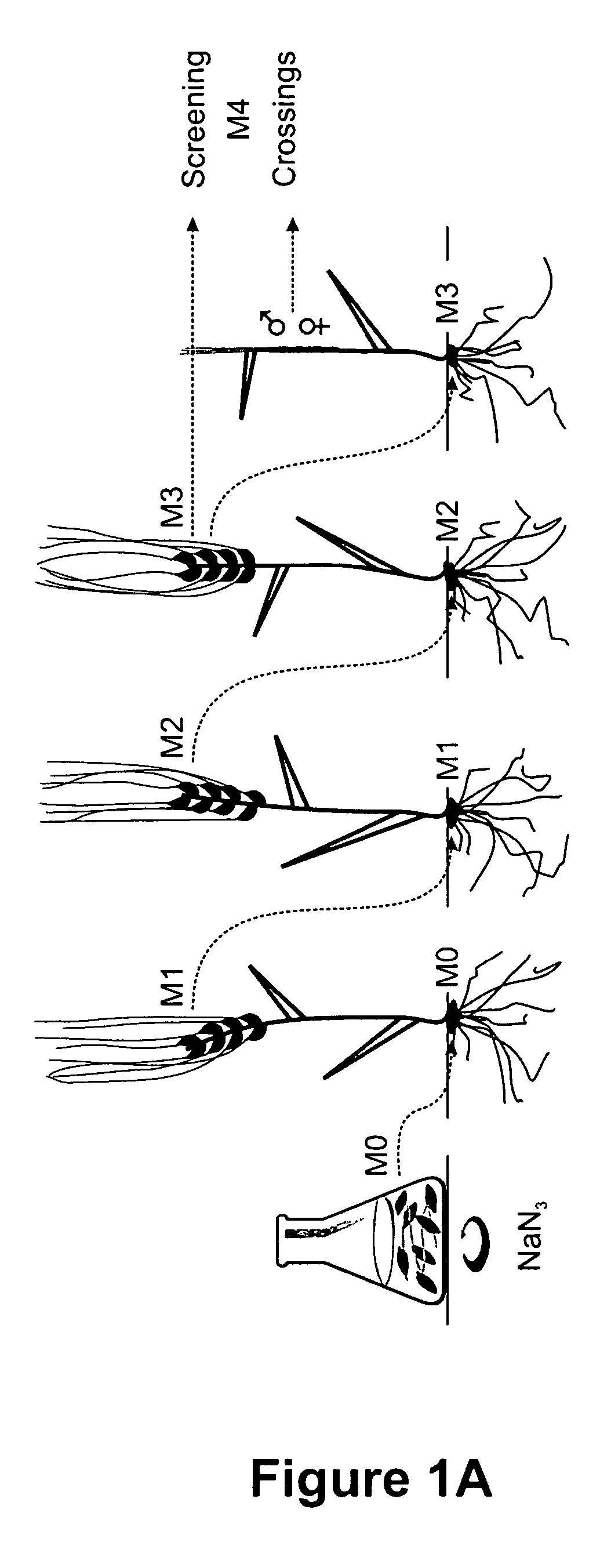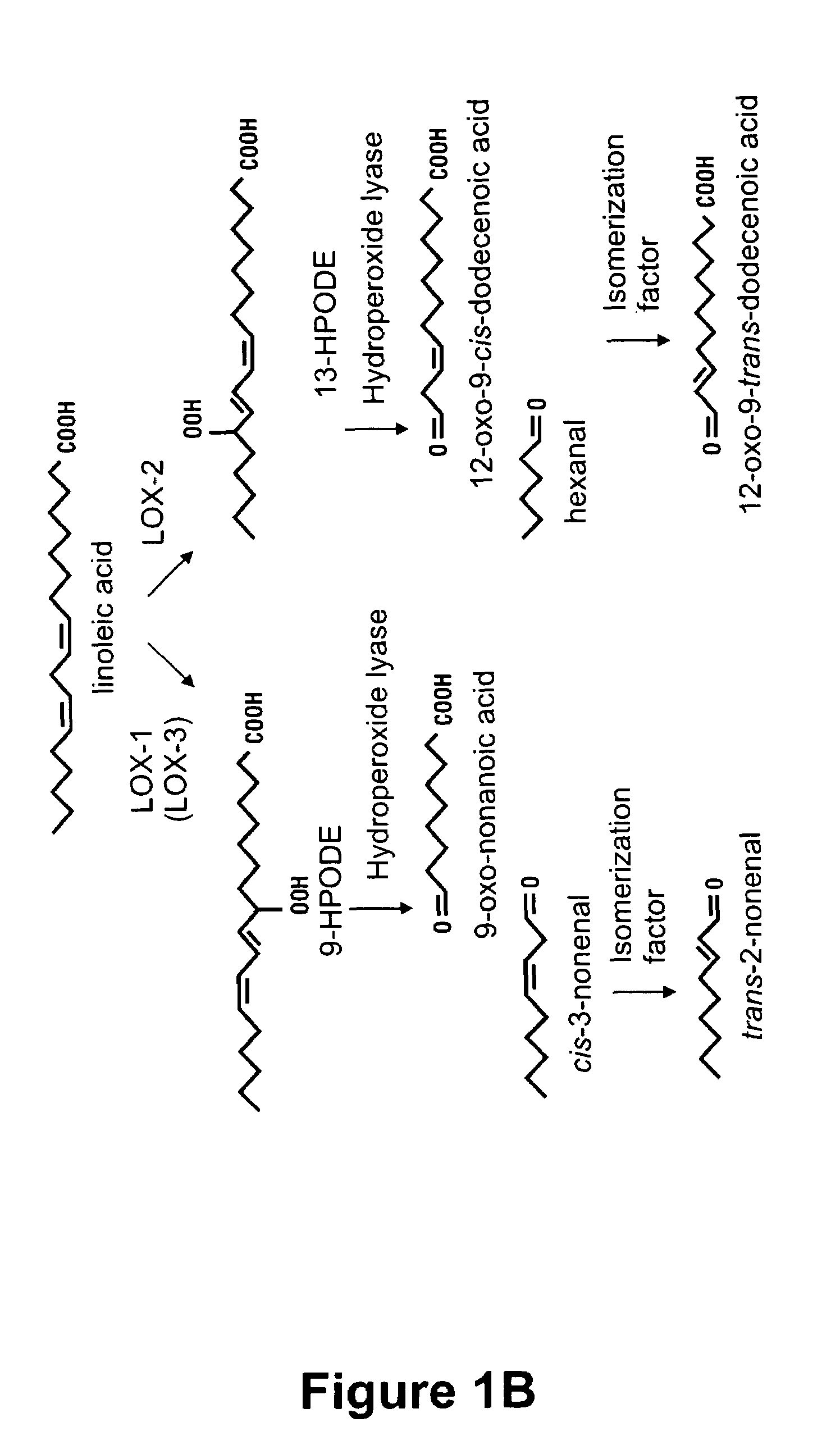Barley for production of flavor-stable beverage
a technology of barley and flavor, applied in the field of plant biotechnology, can solve the problems of inability to specifically, enormous complexity, and breeders cannot predict the outcome of new plant lines under development in a conventional plant breeding process, and achieve the effect of prolonging shelf life and high lox-1 activity
- Summary
- Abstract
- Description
- Claims
- Application Information
AI Technical Summary
Benefits of technology
Problems solved by technology
Method used
Image
Examples
example 1
Screening and Mutant Selection
[0280]Barley mutagenesis. Kernels collected from barley plants of cv.s Barke, Celeste, Lux, Prestige, Saloon, and Neruda were incubated separately with the mutagen NaN3 according to the details provided by Kleinhofs et al. (1978). This procedure was chosen since it is known to induce point mutations in the barley genomic DNA, and confers amino acid substitutions or truncations in those proteins encoded by the mutagenized DNA.
[0281]In the mutagenesis experiments of the instant publication, it was chosen to propagate mutated grains of generation M1 in field plots through two subsequent generations, eventually yielding a high proportion of homozygous plants for screening purposes (FIG. 1). Mutant grains of the resulting M3 generation were expected to occur at a frequency of 0.9-2.3 per 10,000 grains (Kleinhofs et al., supra). It is notable that M2 grains were not screened, primarily because these contain a relatively high proportion of heterozygous point m...
example 2
Barley Mutants D112 and A618
[0287]Analyses were conducted to establish whether null-LOX-1 plants of the M4 and M5 generations were homozygous for the corresponding mutant phenotype. This type of analysis was useful for the determination of the recessive or dominant nature of the mutation of interest in the M3 generation. In other words, if plants of generation M3 generation were heterozygous for a dominant mutation, then subsequent generations would segregate for that phenotype.
[0288]Total LOX activity was measured in embryos of generations M3, M4 and M5 of barley mutants D112 and A618, and the activities were compared with those of embryos from cv. Barke and cv. Neruda, respectively. Determination of LOX activity was as descibed in Example 1 of the instant publication. In all of the experiments, standard extracts from embryos of cv. Barke, as well as heat-inactivated, standard extracts from embryos of cv. Barke, were used as control samples.
[0289]For embryos of generation M4 grains...
example 3
Physiological Properties of Barley Mutants D112 and A618
[0292]Plant propagation in the greenhouse. Grains of cv. Barke and mutant of D112 (generations M4 and M5) were germinated and grown in a greenhouse under 20 h light at 12° C. at a relative humidity of 65%. The growth characteristics of mutant D112 and wild-type cv. Barke plants were similar with respect to plant height, number of tillers per plant, the onset of flowering and the number of grains per spike. Therefore, it can not only be concluded that mutant D112 has a wild-type plant growth physiology, but also a normal grain development.
[0293]Mutant A618 grains of generation M4 and grains of cv. Neruda were germinated and grown in a greenhouse under light / dark conditions of 20 h / 4 h at 12° C. and a relative humidity of 65%. By comparison of mutant A618 and cv. Neruda, no differences were observed with respect to plant height, number of tillers per plant, the onset of flowering and number of grains per spike. However, the dorsa...
PUM
| Property | Measurement | Unit |
|---|---|---|
| taste-threshold | aaaaa | aaaaa |
| taste threshold level | aaaaa | aaaaa |
| temperature | aaaaa | aaaaa |
Abstract
Description
Claims
Application Information
 Login to View More
Login to View More - R&D
- Intellectual Property
- Life Sciences
- Materials
- Tech Scout
- Unparalleled Data Quality
- Higher Quality Content
- 60% Fewer Hallucinations
Browse by: Latest US Patents, China's latest patents, Technical Efficacy Thesaurus, Application Domain, Technology Topic, Popular Technical Reports.
© 2025 PatSnap. All rights reserved.Legal|Privacy policy|Modern Slavery Act Transparency Statement|Sitemap|About US| Contact US: help@patsnap.com



